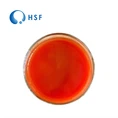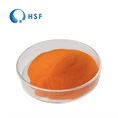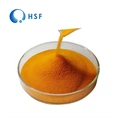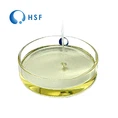Vanillin mainly exists in the natural plant vanilla and is one of the most important spices in the world. The crystals of vanillin are white needles with a unique aroma of vanilla pods. It is slightly soluble in cold water and easily soluble in hot water, ethanol, ether, chloroform and hot volatile oils. Its chemical structure is:

The unique aroma of vanillin makes it widely used in many fields. Vanillin is mostly used in the food industry. It is an indispensable flavoring material for high-end foods. It also plays an important role in flavors, beverages and pharmaceutical industries. The global demand exceeds 16,000 tons per year.
There are two types of vanillin available on the market - synthetic vanillin and natural vanillin. Chemically synthesized vanillin is in greater supply than demand and has a lower market price. This type of vanillin not only has a single flavor, but also has serious pollution during the synthesis process and is unacceptable to people.

Natural vanillin is mainly extracted from natural vanilla, but the planting area of vanilla is limited, the yield is greatly affected by climate, and the labor intensity is high. The price of natural vanillin is extremely expensive, about 300 times that of synthetic vanillin.
The most promising biosynthesis method currently has the advantages of natural and cheap raw materials, clean and pollution-free production process, fast and efficient, etc. The use of biotechnology (microbial transformation method) to produce natural vanillin has become a new channel worthy of promotion.
Chemical synthesis method:
Literature reports that there are many methods for preparing vanillin by chemical synthesis, mainly including conifer glycoside method, lignin method, safrole method, eugenol method, p-hydroxybenzaldehyde method, p-cresol method, guaiacol method, electrolytic oxidation method, etc.
Chemical synthesis has always been the main production process of vanillin. The glyoxylic acid method is the mainstream method for industrial production of vanillin due to its wide source of raw materials, easy to control process conditions, high yield and low pollution. How to improve the condensation yield of guaiacol and glyoxylic acid and select better oxidation catalysts needs further research.
At the same time, chemical synthesis methods also generally have the characteristics of complex products, high process pollution, and low product purity. Therefore, for chemical synthesis methods, whether a low-pollution and high-purity route suitable for industrialization can be developed will determine whether it will have significant application prospects in China.
Plant extraction method
Vanillin is widely present in natural plants in the form of free state and glucoside, especially in vanilla beans, with a content of about 20 g/kg (dry weight). The world's vanilla production areas are currently mainly concentrated in island countries or regions such as Madagascar, Indonesia, Comoros, Liouanni, Uganda, Mexico and Tahiti. The deep-processed products of vanilla are mainly vanilla extracts, which are filtered. This method is costly, time-consuming, and solvents will remain.
The plant extraction method has its own advantages, and the vanillin extracted from the plant vanilla is natural, but due to the limited planting area of vanilla, the yield is greatly affected by climate, and the labor intensity of crop planting and processing is too high, the natural vanillin produced is far from meeting the market demand.

Biotransformation method
The main biotransformation methods include plant cell culture method, enzyme transformation method and microbial transformation method.
Given that vanillin is widely used in the food industry, whether it is natural and healthy has attracted much attention from consumers. Vanillin produced by microbial transformation using natural raw materials as substrates and biotechnology is recognized as natural vanillin by food regulations in Europe and the United States.
The substrates for producing vanillin using microbial transformation are mainly eugenol and ferulic acid.
In industry, eugenol is mainly extracted from plant essential oils such as clove oil, and the price is relatively low, about US$5 per kilogram; however, eugenol has certain toxicity to microorganisms and will inhibit the normal growth and metabolism of bacteria.
Ferulic acid is abundant in nature, cheap and easy to obtain, has no toxic effect on bacteria, and the yield of synthesizing vanillin using it as a substrate is relatively high, making it an ideal raw material.
Among the many vanillin production strains, only a few can reach the level of industrial application. Since vanillin is an inhibitor for bacteria, most strains cannot tolerate high concentrations of vanillin, or some strains have downstream metabolic genes for vanillin that will continue to degrade the generated vanillin, ultimately resulting in a relatively low yield of vanillin. Currently, only multiple strains of the two genera Amycolatopsis and Streptomyces can convert the substrate ferulic acid into a higher yield of natural vanillin, which can be used in industrial production.

Application of Vanillin
Natural vanillin
- Application areas: Mainly used in high-end food, medicine, cosmetics and other fields, especially those products that pursue natural, healthy and high-end quality.
- Features: It has a natural aroma and taste, which can better meet consumers' needs for health and quality. However, due to its high cost, the price is relatively expensive.
Synthetic vanillin
- Application areas: Widely used in food, medicine, daily chemical industry and other fields, especially in products that require a large amount of vanillin, such as chocolate, candy, ice cream and other sweets.
- Features: The price is relatively low and can meet the aroma and taste requirements of general products. However, excessive consumption of synthetic vanillin may have adverse effects on health, such as headaches, nausea and vomiting.
In summary, there are obvious differences in the process and application of natural vanillin and synthetic vanillin. When choosing to use, you should weigh and choose according to specific needs and product characteristics.
|
|
|
|
HSF Biotech's Vanillin
Natural Vanillin produced by HSF Biotech adopts bioconversion method. It is obtained from natural ferulic acid derived from rice bran oil through microbial transformation and corresponding extraction and crystallization processes. The cycle is short, the yield is high, and there is less pollution. After optimizing the fermentation conditions, the quality has reached international standards.
Synthetic Vanillin, provided by HSF is based on R&D innovation, is offered to you through multiple extraction technologies, ensuring high quality. It has been exported to countries all over the world and used in various fields.
For more details, please contact us:
Email: sales@healthfulbio.com
Whatsapp: +86 18992720900










